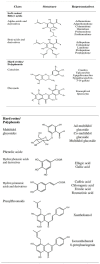Hop Compounds: Extraction Techniques, Chemical Analyses, Antioxidative, Antimicrobial, and Anticarcinogenic Effects
- PMID: 30678345
- PMCID: PMC6412513
- DOI: 10.3390/nu11020257
Hop Compounds: Extraction Techniques, Chemical Analyses, Antioxidative, Antimicrobial, and Anticarcinogenic Effects
Abstract
Hop plants comprise a variety of natural compounds greatly differing in their structure and properties. A wide range of methods have been developed for their isolation and chemical analysis, as well as for determining their antioxidative, antimicrobial, and antigenotoxic potentials. This contribution provides an overview of extraction and fractionation techniques of the most important hop compounds known for their health-promoting features. Although hops remain the principal ingredient for providing the taste, stability, and antimicrobial protection of beer, they have found applications in the pharmaceutical and other food industries as well. This review focuses on numerous health-promoting effects of hops raging from antioxidative, sedative, and anti-inflammatory potentials, over anticarcinogenic features to estrogenic activity. Therefore, hops should be exploited for the prevention and even healing of several prevalent diseases like cardiovascular disorders and various cancer types. New ideas for future studies on hops are finally presented: computational investigations of chemical reactivities of hop compounds, nanoencapsulation, and synergistic effects leading to a higher bioavailability of biologically active substances as well as the application of waste hop biomass from breweries for the production of high-added-value products in accordance with the biorefinery concept.
Keywords: anticarcinogenic effects; antimicrobial effects; antioxidative effects; extraction; hops.
Conflict of interest statement
The authors declare no conflicts of interest.
Figures





Similar articles
-
Green Antimicrobials: Innovative Applications of Hops Extracts as Biocontrol Agents.Pathogens. 2025 Apr 25;14(5):418. doi: 10.3390/pathogens14050418. Pathogens. 2025. PMID: 40430739 Free PMC article.
-
Fundamentals and health benefits of xanthohumol, a natural product derived from hops and beer.Nat Prod Commun. 2009 May;4(5):591-610. Nat Prod Commun. 2009. PMID: 19445313 Review.
-
Flavonoids as Phytoestrogenic Components of Hops and Beer.Molecules. 2020 Sep 14;25(18):4201. doi: 10.3390/molecules25184201. Molecules. 2020. PMID: 32937790 Free PMC article. Review.
-
Antimicrobial Properties of Spent Hops Extracts, Flavonoids Isolated Therefrom, and Their Derivatives.Molecules. 2018 Aug 17;23(8):2059. doi: 10.3390/molecules23082059. Molecules. 2018. PMID: 30126093 Free PMC article.
-
A novel approach for identification of biologically active phenolic compounds in complex matrices using hybrid quadrupole-orbitrap mass spectrometer: A promising tool for testing antimicrobial activity of hops.Talanta. 2016 Aug 15;156-157:209-217. doi: 10.1016/j.talanta.2016.05.018. Epub 2016 May 11. Talanta. 2016. PMID: 27260455
Cited by
-
Fractionation of High-Value Compounds from Hops Using an Optimised Sequential Extraction Procedure.Antioxidants (Basel). 2023 Dec 26;13(1):45. doi: 10.3390/antiox13010045. Antioxidants (Basel). 2023. PMID: 38247470 Free PMC article.
-
Natural Anti-Microbials for Enhanced Microbial Safety and Shelf-Life of Processed Packaged Meat.Foods. 2021 Jul 9;10(7):1598. doi: 10.3390/foods10071598. Foods. 2021. PMID: 34359468 Free PMC article. Review.
-
Comprehensive Two-Dimensional Gas Chromatography-Mass Spectrometry as a Tool for the Untargeted Study of Hop and Their Metabolites.Metabolites. 2024 Apr 19;14(4):237. doi: 10.3390/metabo14040237. Metabolites. 2024. PMID: 38668365 Free PMC article.
-
Green Antimicrobials: Innovative Applications of Hops Extracts as Biocontrol Agents.Pathogens. 2025 Apr 25;14(5):418. doi: 10.3390/pathogens14050418. Pathogens. 2025. PMID: 40430739 Free PMC article.
-
Carcinogenesis of β-Propiolactone: A Computational Study.Chem Res Toxicol. 2020 Mar 16;33(3):769-781. doi: 10.1021/acs.chemrestox.9b00389. Epub 2020 Feb 26. Chem Res Toxicol. 2020. PMID: 32056425 Free PMC article.
References
-
- Labadie R.P., Van Der Nat J.M., Simons J.M., Kroes B.H., Kosasi S., Van Den Berg A.J., Hart L.A., Van Der Sluis W.G., Abeysekera A., Bamunuarachchi A., et al. An ethnopharmacognostic approach to the search for immunomodulators of plant origin. Planta Med. 1989;55:339–348. doi: 10.1055/s-2006-962024. - DOI - PubMed
-
- Higdon J., Drake V.J. An Evidence-Based Approach to Phytochemicals and Other Dietary Factors. Thieme Publishing Group; Stuttgart, Germany: 2012.
Publication types
MeSH terms
Substances
LinkOut - more resources
Full Text Sources
Other Literature Sources
Medical

